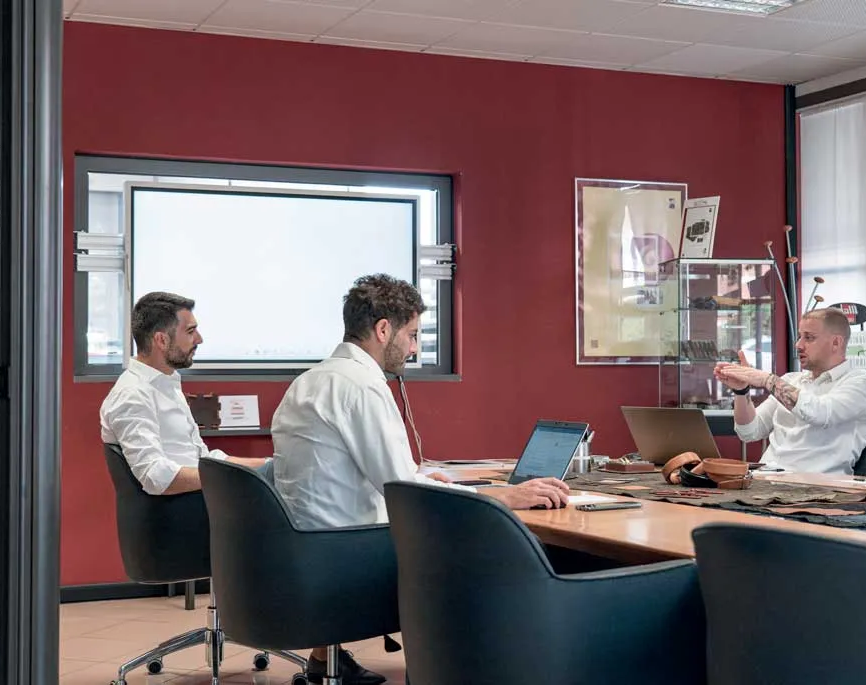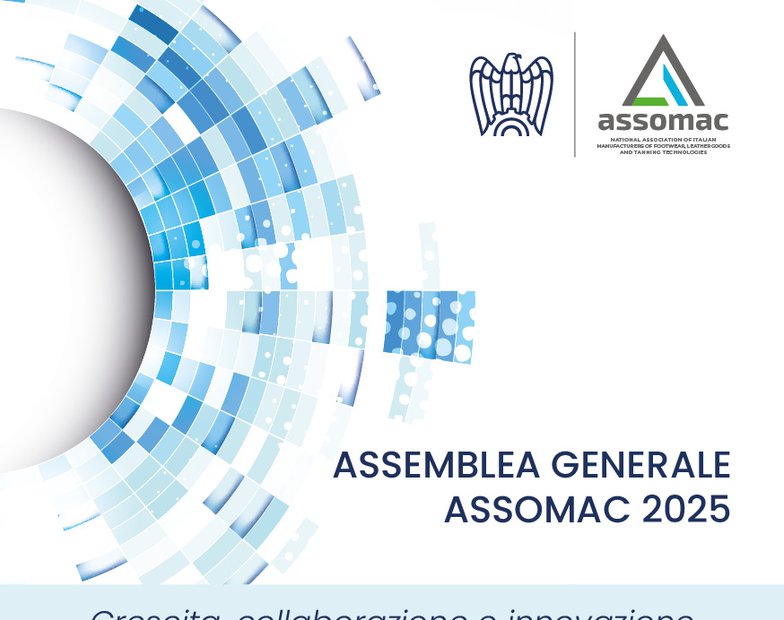Galli SpA is constantly engaged in the research and development of new leather goods machinery that meet the increasingly specific needs of clients. [By MpaStyle]
The customer’s needs are always at the heart of construction for every Galli product. Specializing in the production of machines for the leather goods industry, the Vigevano-based group combines great technical know- how with an almost scientific working method, carrying out the entire manufacturing process in-house. We talked about this with Carlo Galli, CEO of Galli SpA, who showed us the company headquarters, the new departments where the design and manufacture of automated machinery is managed, and the new company organization chart, which came into being after the acquisition of Overmec.
Carlo Galli, many changes have taken place in the company over the past three years that it is easy to forget the transitions. Can you summarize them for us?
During the pandemic period, we focused on several new projects. In the last two years the integration of Overmec within Galli has taken place. Now Overmec has become a brand, no longer being a stand-alone company. We needed to grow internally to give the customer the opportunity to take advantage of various types of machinery. Our two companies, even before being integrated, had the same customers and the same demands. Galli SpA was founded in 1979 and today has over forty years of experience in the leather goods market and particularly in the belt machinery sector, which has always been our main focus. In 2010 the situation evolved and the opportunity arose to enter the leather goods sector in a more present way and with more technology. From here the partnership with Overmec, has become much stronger over time. After its total acquisition in 2019, in 2020, as I mentioned, the corporate merger was realized and the new Galli SpA was born with three plants, all in Vigevano, 100 machine models, 50 employees and more than 30 patents. In the midst of the pandemic, we decided to create a new and unique technology hub, which we so named because it represents one of our strengths in a market that has become increasingly demanding: before, both companies did research and development in a disjointed way, but now each project comes up in a unified way for all production lines. In addition, we saw that training was one of the services among the most demanded by our customers including big names, so we founded an internal Academy that is working very well. Having to train a team of 50 employees from two companies, we were the first users of our Academy. We organize training courses both within the client companies and at our headquarters, where we teach how to use the machinery, but also how to process the materials.
This evolution is the result of a new organization and a generational change desired by my father, and president, who gave credit to the young people involved.
Can we say that today you are a completely different company?
We are a company that has evolved, we have reformed the team, with more than 15 new skills coming in from outside, many young professionals making great contributions, many new things, and also a more effective method. We created new departments – from Quality Control/Certification (with the strong desire to increase the quality of our products) to R&D – and trained people. Each department reports to me or my brother, who is responsible for all production. We have achieved great internal growth and created a structured, solid, young team that my father looks at with admiration.
At the beginning it was not easy to amalgamate the new group, our strength was to focus on many internal young people and their growth by training specific figures: this is how our new structure was born, formed by many skills that we already had internally and of which we are very proud. Among the current employees are some who were already working for us in the past and whom we are happy to have brought back to the company again. For example, the research and development manager in the technical department worked at Galli for three years, then moved to a multinational company and finally returned to us. The sales manager also took a similar path. Others have grown internally, developing new skills by moving from one department to another. I’m speaking of people who are deserving and capable of managing our macro areas where we have been focusing our energy for the last three years to redirect our machinery well. To better understand the demands of the market, you must know that before, machinery was very vertical and specific to certain types of products. Today, opposed to quantity and batch production, you have to be fast with customizations. The pandemic accelerated a change in the type of work that was already in the air: the need for greater adaptability of a machine to more processing variants took over. In short, there was a need to unify models to enable the customer to diversify production by using less machinery.
What specific processes is your machinery designed for?
Colouring has always been our strong point, edge definition and stamping represent a part we have dedicated a lot in recent years and for which there was little technology and research. For this reason, we have found great interest that has allowed us to conduct a very articulate and in-depth work with the skills we brought with us from Overmec, obviously integrating a line of machinery that is starting to create a unified vision.
Therefore you are working on many new machines.
Yes, in this regard we have been working hard. We have also paid special attention to redesigning, resulting in more functionality: touch controls and screens on which you can store data, recall all settings and machine set-up.
Is it possible to store all the processing?
Yes, exactly. This was a result of incorporating Overmec, because creating very autonomous machines was their strength. Overmec was already adopting Industry 4.0 solutions when this topic was not yet being talked about. For everything new, we are integrating 4.0 solutions even on entry-level machines to give all our customers the opportunity to develop their manufacturing on new technologies.
Are there any plans to customize the machines?
Yes, when the customer is also interested in the aesthetics and interfaces of the machine. In this area, the work is exciting and dynamic, as it involves customizing the machine for each brand in terms of colours, shapes, geometries and anything else. In fact, by gathering information directly from our clients, we are even able to create an actual rendering of the machine so that we can prospect the final look of how it would be once positioned within the company in question. Above all, this serves to reduce prototyping time, eliminating the wait for testing, visualization and verification of the result. Everything is sped up.
In what specific sectors do you operate most?
Our main sectors range from leather goods to general merchandise including handbags and wallets, belts, watch straps, while in the field of footwear, although we are not the reference company, we offer machines for classic shoe processing. In the automotive world we are present for some manufacturing of seats, steering wheels and some interior details. Finally, we deal with the promotional segment ranging from gadgets to leather diaries.
I am reminded of a box factory I visited last year in Portugal. Boxes are a product for which there are some Overmec machines specifically for processing the product – this is to say that there is a universe around us with endless possibilities, where markets like Europe offer so much space. In particular, we are very active in Italy, France, Spain and Portugal, and other countries that come by way of that.
Are you operating more with brands or with subcontractors?
Both, although our clients have transformed a lot in recent years through acquisitions. Groups have brought together the various locations of labor within their production and the brand has gone from contractor to conductor managing everything in-house. We in effect dialogue more and more with the brand by being able to work on the target, anticipating what the needs are, what operations are needed, what culture is wanted in the company – all topics that are the core to our work. This is keeping in mind that we are dealing with leather products, which is not easy to work with, and for which robotics must also be used to achieve the desired result. So you have to try to work on these aspects beyond how the machine is made.
With brands, it is essential to propose good and correct solutions aimed at improving the quality of the finished product. We also push ourselves to do the best in terms of the ease of using our machines, offering a recognizable range with a uniform concept: today the operator interfaces are the same, which means that the operator can switch from one machine to another without having to learn how to manage a new interface each time. For the past fifteen years or so we have always designed in 3D, and this allows us to be very flexible and fast in handling new solutions.
Do you aim to virtualize possible solutions for your customers?
Yes, this is in my opinion the next step to Industry 4.0. In addition to providing the data, we also give the ability to monitor it in a concrete way, to virtualize the product even before we physically have it on the work floor. The desire is to support the customer in choosing the layout and type of machine, because often the option is from the catalog by adapting it to what is already there. Instead, we propose to concretize the line already in advance, exposing all our technology and making it clear how far we can go.
Can you describe the machines that can be seen on your virtual catalog?
In general, we are trying to offer always more vertical customization for the customer. So we can create real 3D simulations of the work island or the entire production layout. This helps us and our customers to analyze not only the functionality itself of the machinery but also the dynamics of workflow. In addition, it is very important to pay attention not only to the machining but to everything that revolves around it. Thanks to these simulations we can analyze issues that until some time ago were only seen after the machinery was installed.
Can the client follow the project precisely even from a distance?
Certainly, now with video calls we are obliged to be always present in real time. Today we make custom catalogs for the customer giving the possibility to work on an ad hoc offer with individual codings so that in the choice we do not fall back on generic machinery. We also provide the page with the 3D model specifying what is the particular detail of the machine compared to the others and preview the chosen machinery from the catalog with personal codes. The concept is to offer the customer more and more possibilities, focusing everything on quality, safety and certifications.
In short, with new generation technologies we offer direct experience with the identified machines before even buying them.
Assistance and advice from a team of experts complete an impeccable personalized service.


